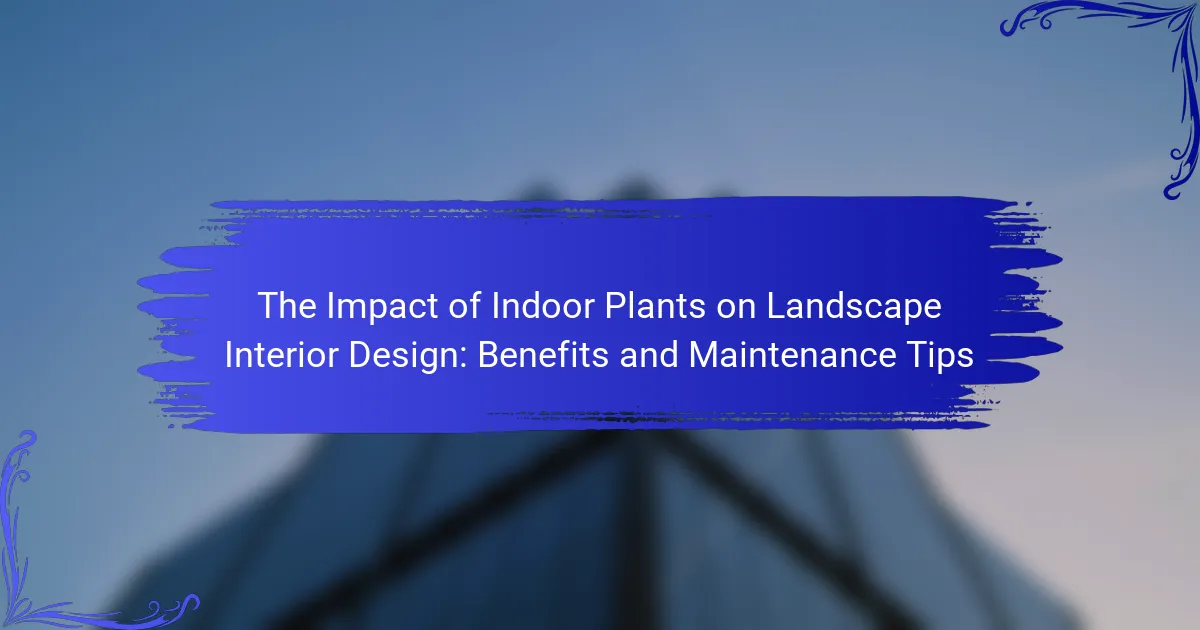Indoor plants are essential elements in landscape interior design, offering numerous benefits such as improved air quality, stress reduction, and enhanced aesthetic appeal. Types of indoor plants include foliage plants like pothos and snake plants, flowering plants such as orchids and peace lilies, and drought-resistant succulents like jade plants and aloe vera. Effective maintenance practices for indoor plants include regular watering, proper lighting, fertilization, pruning, pest monitoring, and repotting. Incorporating indoor plants not only elevates the visual interest of spaces but also contributes to overall health and property value, making them a vital component of interior landscapes.

What is the impact of indoor plants on landscape interior design?
Indoor plants significantly enhance landscape interior design. They improve air quality by filtering toxins and increasing humidity. Studies show that indoor plants can reduce stress and boost mood. The presence of greenery creates a more inviting and aesthetically pleasing environment. Additionally, indoor plants can define spaces and add visual interest. They also contribute to sound absorption, making spaces quieter. Incorporating plants into design can increase property value and appeal. Overall, indoor plants play a crucial role in creating healthier and more attractive indoor landscapes.
How do indoor plants influence the aesthetics of interior spaces?
Indoor plants enhance the aesthetics of interior spaces by adding color, texture, and life. They create a sense of harmony and balance within a room. The presence of greenery can make a space feel more inviting and comfortable. Studies show that indoor plants can improve mood and reduce stress, contributing to a more pleasant environment. Additionally, they can serve as focal points or accents in design, drawing attention and enhancing visual interest. Research indicates that spaces with plants are perceived as more attractive and vibrant. Overall, indoor plants play a significant role in elevating the aesthetic appeal of interior design.
What design principles are enhanced by incorporating indoor plants?
Incorporating indoor plants enhances several design principles, including biophilia, balance, and color harmony. Biophilia emphasizes the connection between nature and humans. Indoor plants foster this connection, promoting well-being and reducing stress. Balance is achieved through the strategic placement of plants, creating visual equilibrium in a space. This can be done by varying plant sizes and shapes. Color harmony is also enhanced by indoor plants, which introduce vibrant greens and other colors that complement interior palettes. Research shows that indoor plants can increase productivity and creativity in workspaces, further supporting their design value.
How do indoor plants affect color and texture in design?
Indoor plants enhance color and texture in design by introducing natural hues and tactile elements. They add vibrant greens that can complement or contrast with existing color palettes. This infusion of color can create a sense of harmony or dynamic interaction within a space. The varying leaf shapes and sizes contribute to visual interest and depth. Textures from plants, such as smooth leaves or rough bark, create layers that enrich the overall design. Studies show that biophilic design, which incorporates nature, improves aesthetic appeal and emotional well-being. Therefore, incorporating indoor plants in design leads to a more inviting and lively environment.
Why are indoor plants important for indoor air quality?
Indoor plants are important for indoor air quality because they can absorb pollutants and release oxygen. Research shows that certain plants can remove harmful substances like formaldehyde, benzene, and trichloroethylene. A study by NASA found that plants like the peace lily and spider plant effectively purify air in closed environments. Additionally, indoor plants increase humidity levels, which can reduce respiratory issues. They also contribute to a sense of well-being, promoting mental health. Overall, incorporating indoor plants into living spaces enhances air quality and supports health.
What specific benefits do indoor plants provide for air purification?
Indoor plants provide significant benefits for air purification. They absorb harmful pollutants such as formaldehyde, benzene, and carbon monoxide. Studies indicate that certain plants can remove up to 87% of indoor air toxins in 24 hours. Plants like spider plants and peace lilies are particularly effective. They also release oxygen, improving overall air quality. Furthermore, indoor plants can increase humidity levels, which can reduce respiratory issues. Research from NASA supports these findings, highlighting the air-cleaning capabilities of various houseplants. These benefits contribute to a healthier indoor environment.
How do indoor plants contribute to overall well-being and health?
Indoor plants contribute to overall well-being and health by improving air quality and enhancing mood. They absorb carbon dioxide and release oxygen, promoting better indoor air conditions. Studies show that plants can reduce airborne toxins, increasing the overall health of occupants. Additionally, being around greenery can lower stress levels and boost mental clarity. Research from the Journal of Environmental Psychology indicates that exposure to indoor plants can improve concentration by up to 15%. This connection to nature fosters a sense of calm and well-being, making indoor environments more pleasant and productive.

What are the different types of indoor plants suitable for landscape interior design?
Foliage plants, flowering plants, and succulents are different types of indoor plants suitable for landscape interior design. Foliage plants like pothos and snake plants offer lush greenery. They improve air quality and require minimal maintenance. Flowering plants, such as orchids and peace lilies, add vibrant colors and visual interest. They can enhance mood and create a welcoming atmosphere. Succulents, including jade plants and aloe vera, are drought-resistant and come in various shapes. They are ideal for modern and minimalist designs. These plant types collectively contribute to aesthetic appeal and environmental benefits in indoor landscapes.
Which indoor plants are best for low-light environments?
Snake plants, pothos, and ZZ plants are among the best indoor plants for low-light environments. Snake plants can tolerate low light and infrequent watering. Pothos thrive in dim conditions and are resilient to neglect. ZZ plants are known for their ability to survive in low-light situations. These plants have adapted to grow in shaded areas, making them suitable for indoor spaces with limited sunlight. Studies show that these plants can improve air quality, even in low-light conditions. Their hardiness makes them ideal choices for those seeking low-maintenance greenery.
What care requirements do low-light plants have?
Low-light plants require minimal light exposure and consistent moisture. They thrive in indirect sunlight, making them ideal for shaded areas. Watering should be done when the top inch of soil feels dry. Overwatering can lead to root rot, so drainage is essential. Fertilization should be limited, typically once every few months, using a diluted liquid fertilizer. Temperature should be kept between 60°F to 75°F for optimal growth. Humidity levels should be moderate, as many low-light plants prefer slightly humid environments. Regularly dusting the leaves helps maintain their health and appearance.
How can low-light plants be creatively arranged in interior spaces?
Low-light plants can be creatively arranged in interior spaces by utilizing various design techniques. Grouping plants of different heights creates visual interest. Placing taller plants in corners and shorter ones on shelves maximizes space. Using plant stands can elevate greenery and draw attention. Hanging plants from ceilings adds depth and dimension. Incorporating plants into furniture, like side tables or bookshelves, integrates nature into the decor. Arranging plants in clusters enhances their impact and creates a focal point. Using decorative pots or containers can complement the overall design theme. These methods not only beautify spaces but also improve air quality and mood.
What are the best indoor plants for enhancing productivity?
The best indoor plants for enhancing productivity include the Peace Lily, Spider Plant, and Snake Plant. Peace Lilies improve air quality by removing toxins. Studies show that cleaner air can lead to better concentration. Spider Plants are known for their ability to absorb carbon monoxide and formaldehyde. This can create a healthier workspace. Snake Plants release oxygen at night, promoting better sleep and alertness. Increased oxygen levels can enhance cognitive function. Other beneficial plants include Pothos and Bamboo Palm, which also contribute to improved air quality. Research indicates that having plants in the workspace can increase productivity by up to 15%.
Which studies support the use of plants in workspaces?
Studies support the use of plants in workspaces by demonstrating various benefits. Research by Dr. Margaret Burchett from the University of Technology Sydney shows that indoor plants improve air quality. The study published in the Journal of Environmental Horticulture found that plants can reduce indoor air pollutants by up to 87%.
Another study by NASA in 1989 highlighted plants’ ability to filter volatile organic compounds. The research indicated that specific plants can significantly decrease levels of harmful substances in the air.
Additionally, a study published in the journal “HortTechnology” by researchers from the University of Queensland found that plants in offices enhance employee productivity and well-being. Participants reported lower stress levels and increased job satisfaction in plant-rich environments.
These studies collectively support the use of plants in workspaces for improved air quality, health benefits, and enhanced productivity.
How can specific plants improve focus and reduce stress?
Specific plants can improve focus and reduce stress through their psychological and physiological effects. For instance, plants like lavender and rosemary are known for their calming scents. Studies show that these scents can lower cortisol levels, which are associated with stress. Additionally, the presence of greenery in workspaces has been linked to increased concentration and productivity. Research indicates that indoor plants can enhance mood and cognitive function. A study by the University of Exeter found that employees in plant-rich environments reported 15% higher levels of well-being and productivity. Thus, incorporating specific plants into indoor spaces can significantly enhance focus while reducing stress levels.

What maintenance tips are essential for indoor plants in landscape interior design?
Indoor plants in landscape interior design require consistent care to thrive. Regular watering is essential, ensuring the soil remains moist but not waterlogged. Proper lighting is crucial; most indoor plants need bright, indirect sunlight. Fertilizing every few months supports growth by providing necessary nutrients. Pruning dead or yellowing leaves encourages healthy new growth. Monitoring for pests helps prevent infestations that can damage plants. Repotting every couple of years allows for root expansion and fresh soil. Maintaining humidity levels can be beneficial, especially for tropical plants. These practices contribute to the overall health and aesthetic of indoor landscapes.
How often should indoor plants be watered?
Indoor plants should generally be watered every 1 to 2 weeks. The frequency can depend on factors such as the plant type, pot size, and environmental conditions. For instance, succulents require less frequent watering compared to tropical plants. Checking the soil moisture is essential. If the top inch of soil feels dry, it is time to water. Overwatering can lead to root rot, while underwatering can cause wilting. Therefore, adjusting the watering schedule based on the plant’s needs is crucial for its health.
What factors influence the watering needs of indoor plants?
The watering needs of indoor plants are influenced by several key factors. These factors include plant species, pot size, soil type, humidity levels, temperature, light exposure, and seasonal changes. Different plant species have varying water requirements. For example, succulents need less water compared to tropical plants. Pot size affects how much soil is available to retain moisture. Smaller pots dry out faster than larger ones. Soil type also plays a critical role; well-draining soils require more frequent watering. Humidity levels impact evaporation rates; higher humidity can reduce watering frequency. Temperature influences plant metabolism and water uptake; warmer temperatures typically increase water needs. Light exposure affects photosynthesis and transpiration; more light can lead to higher water consumption. Lastly, seasonal changes can alter watering needs; many plants require less water in winter.
How can overwatering be prevented?
Overwatering can be prevented by ensuring proper drainage in plant containers. Use pots with drainage holes to allow excess water to escape. Monitor soil moisture levels regularly to determine when to water. Water only when the top inch of soil feels dry. Adjust watering frequency based on the plant species and environmental conditions. Consider using self-watering pots to regulate moisture levels. Implementing these practices can significantly reduce the risk of overwatering.
What are the best practices for fertilizing indoor plants?
The best practices for fertilizing indoor plants include using a balanced fertilizer at the right dilution. Indoor plants typically require less fertilizer than outdoor plants. It is essential to follow the manufacturer’s instructions for application rates. Fertilizing during the growing season, which is usually spring and summer, promotes healthy growth. Reducing or stopping fertilization during the dormant season helps prevent nutrient buildup. Observing the plant for signs of nutrient deficiency can guide adjustments in fertilization. Regularly flushing the soil with water can help remove excess salts. Lastly, using organic fertilizers can enhance soil health and promote beneficial microorganisms.
Which types of fertilizers are most effective for indoor plants?
Water-soluble fertilizers are most effective for indoor plants. These fertilizers provide essential nutrients quickly and are easily absorbed by plants. Common types include balanced NPK fertilizers, which contain nitrogen, phosphorus, and potassium in equal ratios. Liquid fertilizers can also be beneficial, as they allow for precise application and immediate nutrient availability. Slow-release fertilizers are effective for long-term feeding, gradually releasing nutrients over time. Organic options, such as fish emulsion or seaweed extract, offer additional benefits like improved soil health. Research indicates that water-soluble fertilizers promote healthy growth and vibrant foliage in indoor plants.
How can fertilization schedules be tailored to different plant types?
Fertilization schedules can be tailored to different plant types by considering their specific nutrient needs and growth stages. For instance, flowering plants often require higher phosphorus levels during blooming. Vegetables typically benefit from balanced fertilizers throughout their growth cycle. Succulents need minimal fertilization, usually once in spring and summer.
Understanding the growth habits of each plant helps in scheduling. Fast-growing plants may need more frequent fertilization than slow-growing varieties. Additionally, soil type affects nutrient availability. Sandy soils drain quickly and may require more frequent applications.
Regular soil testing can provide insights into nutrient deficiencies. This data allows for precise adjustments to fertilization schedules. Adapting schedules based on seasonal changes also optimizes plant health. For example, indoor plants may need less fertilizer during winter dormancy.
Overall, customizing fertilization schedules enhances plant growth and vitality.
What common pests and diseases affect indoor plants, and how can they be managed?
Common pests affecting indoor plants include aphids, spider mites, and mealybugs. These pests can cause damage by sucking sap from the plants. Diseases such as root rot and powdery mildew also frequently affect indoor plants. Root rot is often caused by overwatering, leading to fungal growth. Powdery mildew appears as a white, powdery substance on leaves, usually due to high humidity and poor air circulation.
Management strategies include regularly inspecting plants for signs of pests or disease. Insecticidal soap or neem oil can be effective against pests. For root rot, reducing watering frequency and ensuring proper drainage can help. To combat powdery mildew, increasing air circulation and using fungicides can be beneficial. Implementing these practices can maintain the health of indoor plants effectively.
What are the signs of common indoor plant pests?
Common indoor plant pests display several signs that indicate their presence. Yellowing leaves often signal pest infestation. Wilting or drooping leaves can also occur due to pest damage. Visible holes in leaves indicate that pests are feeding on the plant. Sticky residue on leaves or surfaces suggests the presence of sap-sucking insects like aphids. Webbing on plants is a sign of spider mites. Additionally, small black or brown specks on leaves may indicate the presence of insect droppings. Regular inspection of plants helps in early detection of these signs.
How can natural remedies be used to combat indoor plant pests?
Natural remedies can effectively combat indoor plant pests through various methods. Essential oils, such as neem oil, act as natural insecticides. They disrupt the life cycle of pests and deter them from infesting plants. Soap sprays, made from natural ingredients, can suffocate soft-bodied insects like aphids and spider mites. Diatomaceous earth, a natural powder, damages the exoskeletons of insects, leading to dehydration. Garlic and pepper sprays can repel pests due to their strong odors. These remedies are environmentally friendly and safe for indoor use. Studies show that natural pest control methods reduce chemical exposure and promote healthier plant growth.
What practical tips can help ensure the longevity of indoor plants in design?
To ensure the longevity of indoor plants in design, provide proper care and maintenance. Choose the right plants for your environment. Consider light, humidity, and temperature conditions. Water plants according to their specific needs. Overwatering can lead to root rot. Use well-draining soil to promote healthy root growth. Fertilize regularly with appropriate nutrients to support growth. Prune dead or yellowing leaves to encourage new growth. Monitor for pests and diseases to take timely action. These practices help maintain plant health and enhance interior design aesthetics.
The main entity of this article is indoor plants and their impact on landscape interior design. Indoor plants improve air quality, enhance aesthetics, and contribute to overall well-being by reducing stress and boosting mood. The article discusses various types of indoor plants suitable for different environments, their air purification benefits, and the design principles they enhance. It also provides maintenance tips for ensuring the longevity of indoor plants, including watering, fertilization, and pest management strategies. Overall, the article emphasizes the significant role of indoor plants in creating healthier, more attractive indoor spaces.
